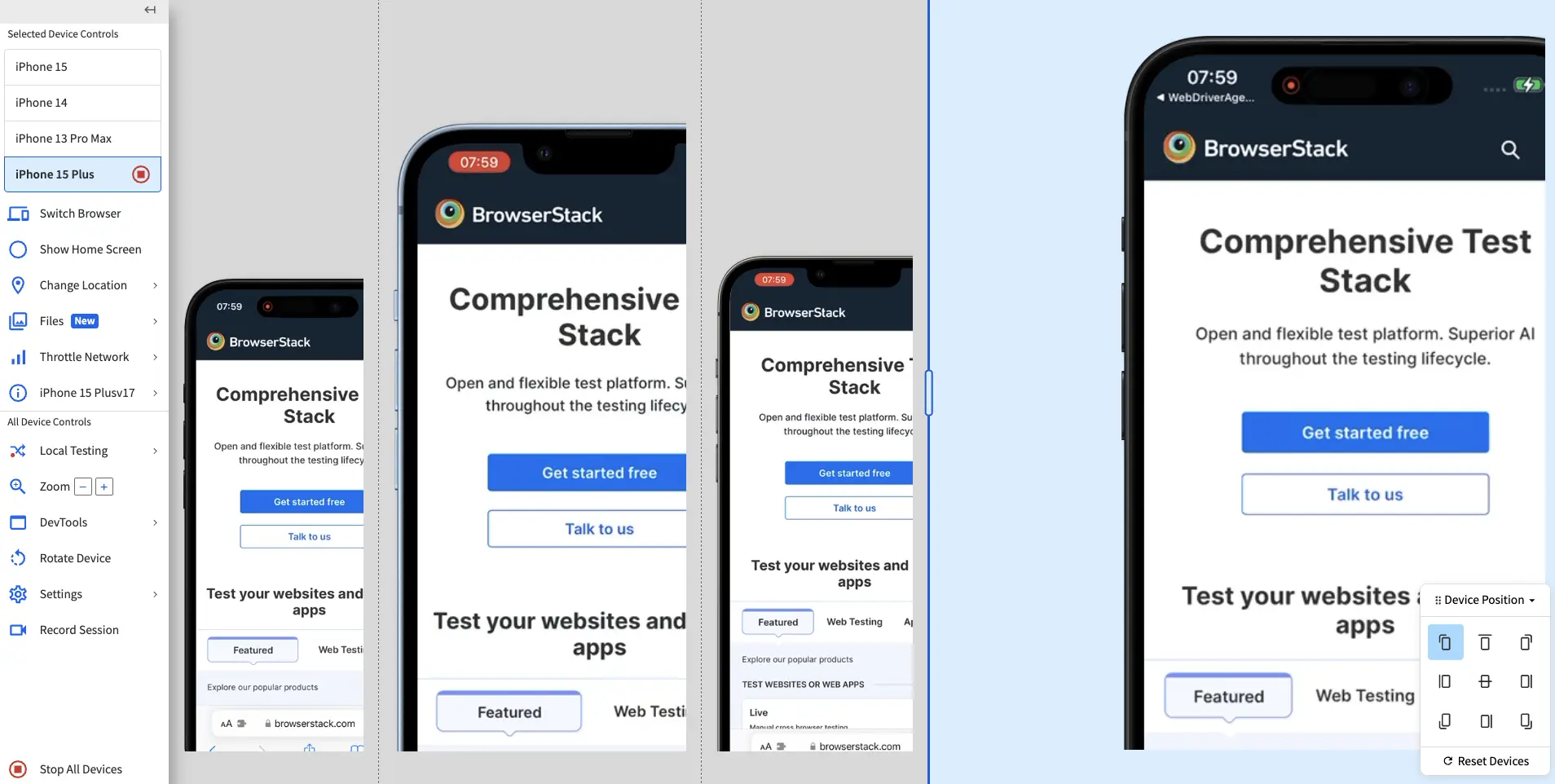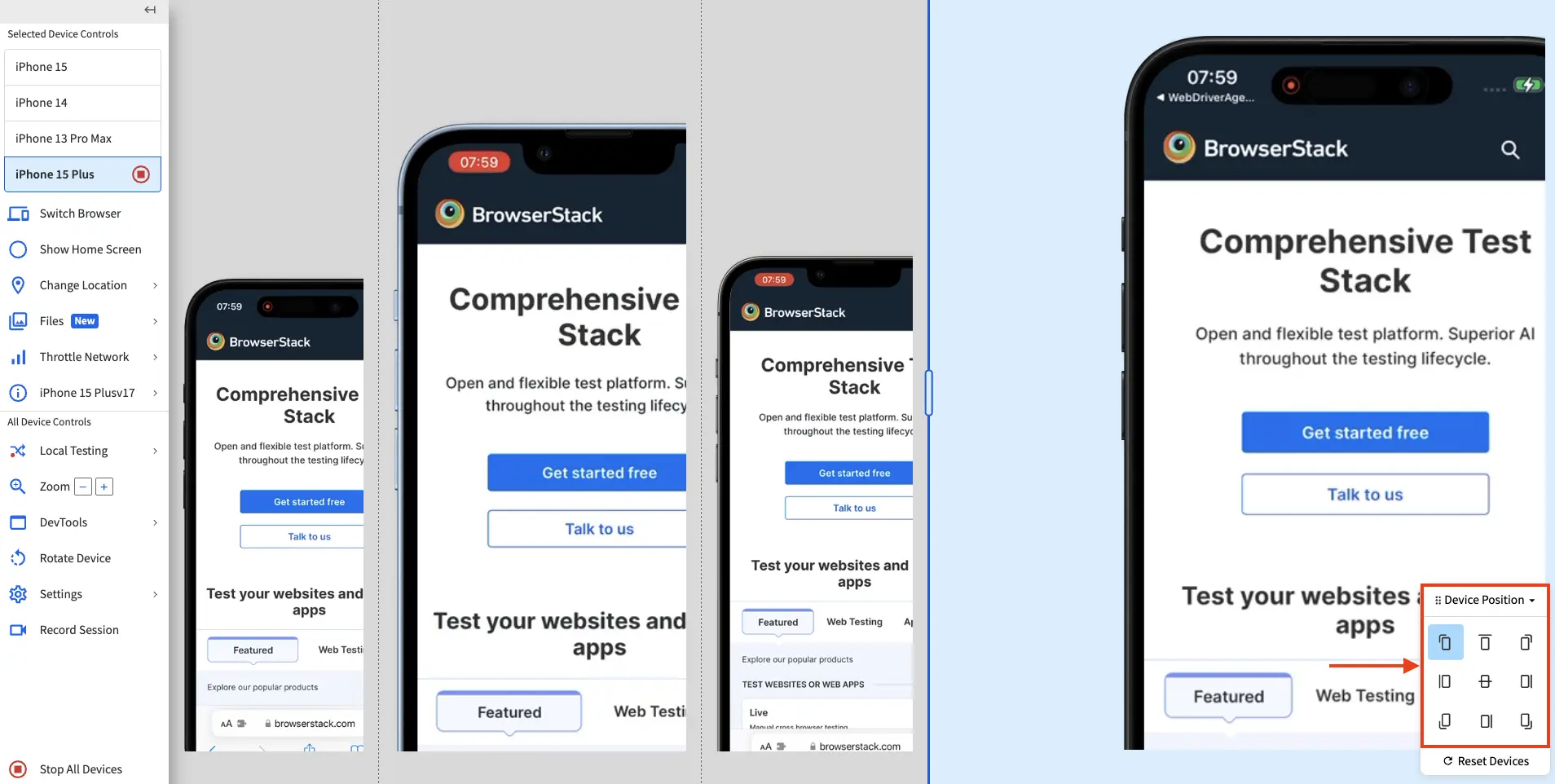Multi-Device Testing in a single tab
Note:
- Multi-Device Testing will only be available in the Team Pro plan and above from July 1, 2024. Upgrade your plan for continued access.
- Multi-Device Testing runs only on Google Chrome and Firefox (this is the browser that you are using to access the Live session).
- Multi-Device Testing in a single browser tab supports up to four BrowserStack real devices.
You can test your website or web application on up to four devices simultaneously in a single tab. For example, in a single tab, you can simultaneously test a website on an iPhone 13, an iPad 9th Generation, Pixel 7, and an OnePlus 11R.
Use cases
- Test your website or web application on families of device-browser combinations simultaneously and compare them side by side.
- Seamlessly remove and add device-browser combinations as you continue testing.
- Use a variety of features such as interaction sync, rotate, and zoom across all devices.
Supported devices
Vivo, Oppo, and Huawei devices are not supported on multi-device testing in a single browser tab.
| Supported Devices | OS Version |
|---|---|
| iPhone and iPad | iOS 11 and above |
| Samsung Galaxy, Google Pixel, OnePlus, Motorola, Xiaomi, RealMe |
Android 7 and above |
Test on multiple devices in a single tab
To test on multiple devices in a single tab, follow these steps:
- Log in to the Live dashboard.
- Select your preferred device-browser combination to run your website or web app.

- Click the Add Device button on the vertical toolbar, or the Plus sign next to the device to open the device and browser selection window.

- In the device and browser selection window, choose another device-browser combination to add the device.

- Repeat steps 3 and 4 to add up to four devices in total.
- Open your test website on all four devices and use the toolbar options and other interactions to perform tests on all devices simultaneously.
See Synchronize interactions across devices to mirror interactions on all the added devices.

Toolbar options
In a single tab multi-device testing session, the Live toolbar gets divided into two categories: Selected Device Controls and All Device Controls.

-
Selected Device Controls: These controls affect only the active device.
An active device is the currently selected device. The name of the active device is highlighted with a blue background in the toolbar and the device itself is also highlighted with a blue background. - All Device Controls: These controls affect all devices in the session.
Selected Device Controls
You can use the following toolbar options on the active device:
- Device and browser information: Displays the device and browser information. You can also use this option to stop testing on a single device.
- Switch Browser: Switches between device-browser combinations during an ongoing test session.
- Change Location: Sets the location for the active device. You can simultaneously set different locations on different devices to compare how your website loads and behaves in various locations.
- Files: Allows you to test file-based scenarios such as uploading and downloading a file. To know more about how to test file-based scenarios, see Upload files to BrowserStack real devices and Download files to BrowserStack real devices.
- Throttle Network: Allows you to simultaneously set different network conditions on different devices to compare how your website loads in various network conditions. To know more about network throttling, see Test using Throttle Network on iOS and Android devices
The following video demonstrates how you can simultaneously test your website in various locations and network conditions by setting different locations and network conditions on the selected devices.
All Device Controls
You can use the following toolbar options on all devices simultaneously:
- Local testing: Configures Local Testing settings. To know more about Local Testing, see Local Testing - Overview.
- Zoom: Zooms in or zooms out of the devices.
- DevTools: Opens DevTools to see debugging information for your website on up to four devices simultaneously. To know more about DevTools, see Debug your website with DevTools on mobile.
- Rotate Device: Rotates devices horizontally or vertically.
- Settings: Configures settings such as enabling interaction sync, self-signed certificate support, and setting idle session timeout.
- Record session: Records the test session. To know more about recording a session, see Record your test session.
- Stop All Devices: Stops all devices and closes the session.
Synchronize interactions across devices
Interaction sync is currently in the beta phase.
Multi-session mode with interaction sync is a patent of BrowserStack. To read more about how it works, see the patent: Multisession mode in remote device infrastructure.
With BrowserStack Interaction Sync, any action you perform on one device is automatically mirrored across all connected devices, ensuring a seamless and synchronized testing experience.
You must add at least two devices to your test session to enable Interaction Sync. The time it takes to enable Interaction Sync may vary slightly depending on the number of devices you select.
To manage interaction sync on multiple BrowserStack devices in a single tab:
- Start a Live session and add the devices on which you want to test.
- On any device tab, click the Sync button in the device background. Enabling this feature restarts the devices, activates self-signed certificate, and disables the network throttling feature.

A status prompt displays the progress of enabling interaction sync.

When interaction sync is enabled, the status prompt closes and you can now interact with one device and your actions are replicated on all of the other devices. - To stop interaction sync, click the Stop sync button on any device tab. The devices restart and interaction sync is disabled.

Interaction sync limitations
Interaction sync has the following limitations:
- All devices must have the same URL and browser open. You may need to enter the URL manually if the devices don’t sync.
- If the URL is the same on all devices and interaction sync is not working, then try refreshing the page as a workaround.
- Interaction sync may not work on certain websites.
- You may experience interactions sync issues on iPhones running iOS 13 or earlier versions.
- Interaction sync is not supported on Vivo, Oppo, and Huawei devices.
- Scrolling sensitivity may occasionally vary.
Advanced features and controls
The following enhancements expand the capabilities of Multi-Device Testing in a single tab:
Resize devices
- When you have multiple devices open, you can resize the devices by dragging the vertical edges between devices.

Zoom, scroll, and pan
You can zoom in and out of devices using the Zoom device control in the Vertical Toolbar. Once zoomed in, use one of the following methods to scroll and pan:
-
To scroll and pan on a single device, move your cursor outside the device screen to its background, and use gesture navigation.

-
To scroll and pan across all open devices at the same time, use the Device Position widget.

Pin devices
- When you have more than one device open, you can pin a device using the pin button in the device background. You can pin only one device at a time.

- When you pin a device, the other devices rearrange into a vertical stack on the right.

- You can resize the unpinned devices by dragging the horizontal edges between them. The pinned device can’t be resized.

- To unpin a device, click the unpin button in that device’s background.

Reset devices to their default size and layout
- To reset all devices to their default size, click the Reset Devices widget.

Maintain browser state
- You can persist cookies across sessions for all devices in a single tab multi-device testing session. To enable this feature, switch on the Persist cookies for future sessions toggle in the Settings prompt. For more information, see Browser State Maintenance with Multi-device testing.

We're sorry to hear that. Please share your feedback so we can do better
Contact our Support team for immediate help while we work on improving our docs.
We're continuously improving our docs. We'd love to know what you liked
We're sorry to hear that. Please share your feedback so we can do better
Contact our Support team for immediate help while we work on improving our docs.
We're continuously improving our docs. We'd love to know what you liked
Thank you for your valuable feedback!